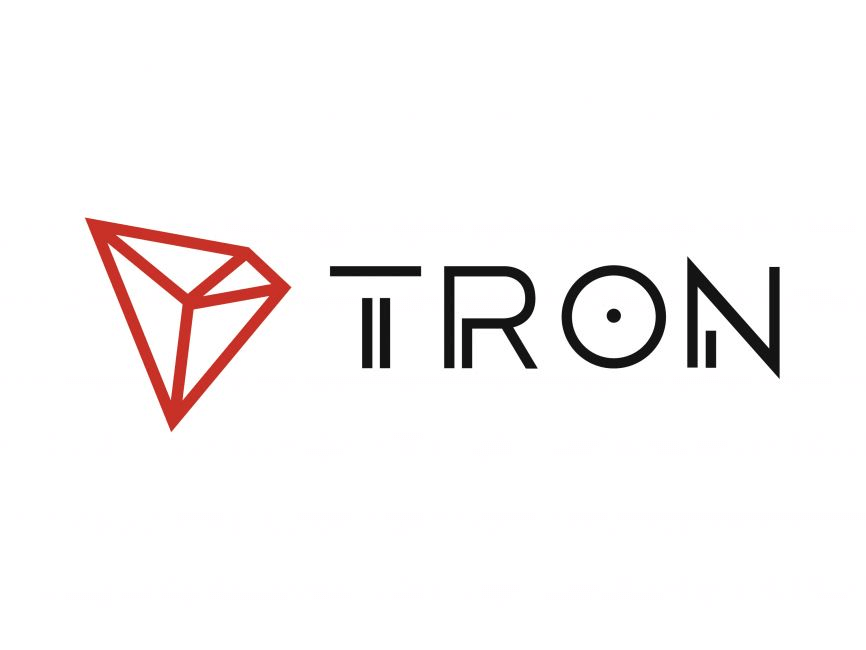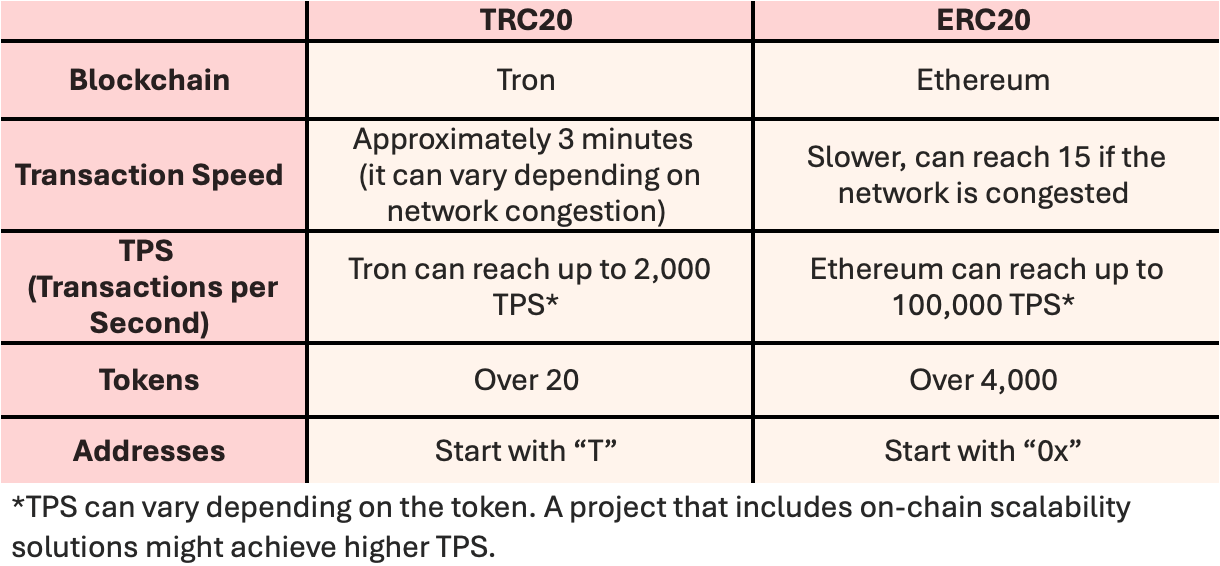Crypto has come such a long way that you can choose from thousands of digital tokens, each coming with its benefits and utilities. As the crypto community grows, so does the technology and that supports it.
Among the numerous token standards available, ERC20 and TRC20 are two of the most popular and widely used in the crypto industry. But why is that, and how do they differ from one another?
In this article, we aim to discover together the key differences between TRC20 and ERC20, explore how tokens interact with smart contracts, and discuss their impact on the broader crypto ecosystem.
Whether you are a seasoned trader or just getting started in the world of digital currencies, understanding these token standards will help you work with crypto more effectively.
What Is TRC20?

TRC20 is a token standard used for developing and employing smart contracts on the Tron blockchain. This protocol serves as the foundation for many digital tokens within the Tron network, which is a blockchain well known for its high transaction speed and low fees. Basically, TRC20 is to the Tron network what ERC20 is to the Ethereum network, facilitating the seamless creation and management of tokens.
The TRC20 standard ensures compatibility between the numerous tokens and decentralized applications (dApps) developed and available on the Tron blockchain. It provides developers with a set of predefined rules and functions, such as transferring tokens, withdrawing token balances, managing the token supply, and interacting with other tokens. By adhering to these rules, tokens can efficiently operate in the Tron ecosystem, allowing for complex transactions and constant interaction with other smart contracts and tokens.
TRC20 tokens usually work based on the Tron Virtual Machine (TVM), which operates in a manner similar to the Ethereum Virtual Machine (EVM) we all are used to. This similarity means that developers familiar with Ethereum’s Solidity programming language can easily adapt to creating TRC20 tokens, as both platforms use the same language for smart contracts.
This cross-compatibility is a known design choice made by the Tron team. The developers wanted to make the Tron blockchain a remarkable alternative to Ethereum, aiming to attract developers with its promise of lower transaction costs and faster processing times.
In the crypto community, TRC20 crypto tokens are widely known and used thanks to their efficiency, especially by investors or traders who prioritize quick transaction speed and lower fees. These features make TRC20 an appealing option for developers looking to deploy digital tokens or create new types of decentralized applications without the higher costs associated with other blockchain networks.
What Is ERC20?

ERC20, which stands for “Ethereum Request for Comments 20,” is a technical standard used for issuing and managing tokens on the Ethereum blockchain. It is one of the most widely adopted protocols in the crypto community for creating smart contracts on the Ethereum blockchain network if not even the most popular token protocol.
The ERC20 standard provides a set of rules that all Ethereum-based tokens must follow, ensuring that different types of tokens will be compatible with a broad range of applications, such as wallets, exchanges, and decentralized applications (dApps).
This allows Ethereum to provide a complete ecosystem that provides anything crypto enthusiasts might need to purchase, sell, or transfer tokens, as well as complete many other crypto-related activities.
At its core, the ERC20 standard defines a common list of rules that an Ethereum token has to implement, giving developers the ability to program how new tokens will function within the Ethereum ecosystem.
This includes how tokens are transferred between addresses and how data within each token is accessed. By standardizing the approach, ERC20 greatly simplifies the process of integrating new tokens into existing systems and applications.
The ERC20 token standard developed 9 functions that help manage the token balance and that developers should include when building the smart contract to generate an ERC20 token, 6 of them being required, while the other 3 being optional. The functions include:
- TotalSupply (required): Returns the entire total token supply generated for a project;
- BalanceOf (required): Returns the account balance held by a certain address;
- Transfer (required): Allows an address to transfer tokens to another;
- Approve (required): An address can authorize another one to use tokens on its behalf;
- TransferFrom (required): Allows an address to receive tokens from another that was approved to transfer;
- Allowance (required): Returns the tokens an address can spend on behalf of another;
- Name (optional): Returns the token’s name;
- Symbol (optional): Returns the token’s emblem;
- Decimals (optional): Returns the number of decimals the token can be divided into.
ERC20 tokens are usually designed to contribute to the creation of complex functions, such as voting rights and staking mechanisms. The implementation of smart contracts using the ERC20 standard allows for a decentralized governance system, making ERC20 tokens crucial players in the Ethereum ecosystem.
Through the ERC20 protocol, the Ethereum network has developed a complex environment for the crypto industry, leading to the development of a diverse range of digital tokens, each serving different purposes and markets.
TRC20 vs ERC20

Blockchain Network
ERC20 tokens operate on the Ethereum blockchain, which is renowned for its robust smart contract capabilities and wide adoption. The network is supported by the Ethereum Virtual Machine (EVM), allowing for complex contract operations and a broad range of decentralized applications (dApps).
On the other hand, TRC20 tokens are based on the TRON blockchain, which aims to optimize for higher transaction speed and lower transaction fees. The TRON blockchain uses the TRON Virtual Machine, a more efficient clone of the EVM, designed to be compatible with Ethereum’s programming language, Solidity, but providing faster processing times.
Transaction Speed and Fees
One of the main challenges with ERC20 tokens is related to their transaction costs, commonly known as “gas fees,” which can vary and become quite high during network congestion. For instance, at the time of writing, the average transaction fee on Ethereum is around $4.5. This aspect can affect the number of users choosing to trade ERC20 tokens.
Besides, Ethereum has encountered situations when the network was too crowded to support all the transaction requirements, thus reaching even higher fees and transaction times.
TRC20 tokens generally offer lower transaction fees and faster processing times compared to ERC20. For example, at the time of writing, the network fee for a TRC20 token transfer is a little over $1. This makes Tron tokens a preferred choice for users looking for quicker and more cost-effective token transfers, which is particularly beneficial in high-volume trading situations.
Compatibility and Adoption
ERC20 tokens have one great advantage: they are part of a vast ecosystem and are supported by a wide range of wallets and exchanges. This widespread compatibility has facilitated a remarkable ecosystem comprising numerous tokens and projects. ERC20 tokens gather thousands of crypto projects, and the number keeps on increasing.
While TRC20 tokens are catching up in terms of ecosystem support, they are often seen as part of a network that is still expanding its reach and adoption. TRC20’s compatibility with Ethereum’s Solidity language helps eliminate gaps for developers transitioning between the two platforms.
Use Cases and Community
The Ethereum community is larger and typically engages with a broader range of decentralized applications, finance solutions, and corporate blockchain implementations. This diversity contributes to a rich environment and innovative use cases of ERC20 tokens.
On the other hand, TRC20 tokens are prominently used in applications that require fast and frequent transactions, such as in some gaming and social media platforms developed on the TRON network. The TRON Foundation’s focus on media and entertainment aligns with the practical use cases of TRC20.
Address Styles
Of course, addresses differ for ERC20 and TRC20 tokens. Thus, ERC20 follows the address style of all Ethereum tokens, starting with “0x.”
On the other hand, Tron addresses are a little different from those of Ethereum-based crypto projects, starting with”T.”
Top TRC20 Tokens
The TRON network hosts a variety of TRC20 tokens that contribute significantly to its ecosystem. Below, we’ll explore five of the most prominent TRC20 tokens, discussing their utility, market presence, and distinctive features.
1. USDT (Tether on TRON)
USDT is the TRON-based version of Tether, primarily used for providing stability and a solution against volatility in the crypto markets. It’s pegged 1:1 with the US dollar, offering a stable store of value and medium of exchange.
As a TRC20 token, USDT benefits from TRON’s low transaction fees and fast processing times, making it a popular choice for traders who require swift and economical transfers.
2. BitTorrent (BTT)
BTT is used within the BitTorrent ecosystem, which is one of the largest decentralized networks in the world. It incentivizes users to share their bandwidth and resources, improving the network’s overall performance and speed.
The token integrates blockchain technology into a well-established peer-to-peer (P2P) file-sharing service, enhancing its functionality with a blockchain-driven incentive structure.
3. WINkLink (WIN)
WIN is the native token of WINkLink, a decentralized oracle network on the TRON blockchain. The project is focused on providing reliable data feeds to enable smart contract execution. It allows developers to connect with one another and real-world data, as well as connect smart contracts with real-world data feeds.
WINk leverages the TRON blockchain’s capabilities to offer a transparent environment, with all transactions recorded on the blockchain ensuring the decentralized manner of the platform.
4. JUST (JST)
JST is the governance token for the JUST platform, a decentralized finance (DeFi) system built on TRON. It’s used for paying interest, participating in governance through voting, and other utilities within the JUST ecosystem.
JST allows users to engage directly with a suite of DeFi products offering loans, staking, and governance mechanisms, all facilitated by the low-cost and high-speed features of the TRON network.
5. Sun (SUN)
SUN is a social experiment dedicated to developing TRON’s DeFi ecosystem. It serves as the primary governance token of the SUN.io platform, which focuses on decentralized stablecoin swap, yield farming, lending, and other financial services.
As a governance token, SUN enables holders to participate in decision-making processes that determine the platform’s development, including feature updates and protocol adjustments.
Top ERC20 Tokens
The Ethereum network, with its bright smart contract features, has become a fertile ground for a wide variety of ERC20 tokens. Each of these tokens leverages the network’s features to offer unique functionalities and solutions.
1. Chainlink (LINK)
Chainlink is a decentralized oracle network that enables smart contracts on Ethereum to securely interact with external data feeds, events, and payment methods. It is crucial in bridging the gap between blockchain and off-chain applications.
LINK, the network’s token, is used to pay for services on the network, including data retrieval, formatting, and off-chain computation. It incentivizes data providers to act honestly and ensures the accuracy of data used by smart contracts.
2. USD Coin (USDC)
USDC is a stablecoin that is pegged 1:1 with the US dollar, offering crypto users stability not affected by the volatility of the cryptocurrency markets (that much). It’s widely used for trading, savings, and other financial transactions where currency stability is crucial.
As an ERC20 token, USDC benefits from the security and interoperability of the Ethereum network, making it easily integrated into wallets, exchanges, and other financial applications.
3. Uniswap (UNI)
Uniswap is one of the most popular and widely used decentralized crypto exchanges (DEXs) on the market, having led the way in the field for some time now. It allows for peer-to-peer (P2P) market making, offering users a bright way of trading various cryptocurrencies without the need for a centralized third party.
The native token of the Uniswap ecosystem is UNI. UNI can be used for numerous activities, including as a governance token (allowing you to take part in the voting process), liquidity mining, and community treasury.
4. Basic Attention Token (BAT)
BAT is an essential part of the Brave browser’s blockchain-based digital advertising platform. It was developed by the co-founder of Mozilla and Firefox, Brendan Eich, in order to improve the security, efficiency, and safety of digital advertising by leveraging blockchain technology.
BAT is the native token of Brave, which is the web browser built on top of the Ethereum network. Users receive BAT for viewing ads and can use tokens to support content creators directly, fostering a new way of interacting with online content and advertising.
5. Aave (AAVE)
Aave is a decentralized crypto platform that allows people to lend and borrow crypto. It uses smart contracts to automate the lending or borrowing process, dictating how funds are distributed, collateral is handled, and fees are required. Lenders earn interest by depositing digital assets into specially created liquidity pools, while borrowers can then use these pools to take out loans using their crypto as collateral.
AAVE, the protocol’s native token, provides holders with discounted fees on the platform, and it serves as a governance token, giving owners a say in the future development of the protocol.
FAQ
Which one is better, TRC20 or ERC20?
Each of the two token standards come with their benefits and downsides. While TRC20 is faster and has lower fees, ERC20 has a wider range of cryptocurrencies available. In the end, your decision strongly depends on your priorities.
Can I transfer TRC20 to ERC20?
Yes, you can transfer some specific TRC20 tokens to ERC20. For instance, USDT is available on both token standards.
Are TRC and TRX the same?
No, TRC20 is the token standard based on the Tron blockchain, while TRX is the native and governance token of the Tron ecosystem.
Is TRC the same as ERC?
No, TRC20 is the token standard developed on the Tron blockchain, while ERC20 is the one built on top of the Ethereum network. Each token standard has its own features.
How do I know if my USDT is ERC20 or TRC20?
You simply have to look at the address. TRC20 addresses start with “T,” while ERC20 addresses start with “0x,” just like any Ethereum-based crypto project.
In Conclusion
Both TRC20 and ERC20 are bright token standards, and they have their similarities, especially considering that TRON was built as an alternative to Ethereum and uses the same programming language as ETH, Solidity.
When it comes to the comparison between the two, you can easily see that Tron tends to be a bit faster and provide lower transaction fees, but no network can yet exceed Ethereum’s number of crypto projects, right?
Thus, each token standard has its unique features and potential flaws, but you have to carefully build your plan in order to choose what’s best for your funds.


